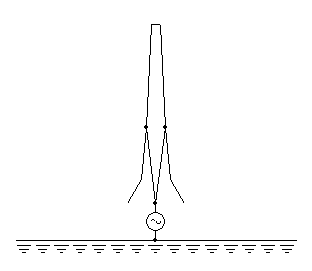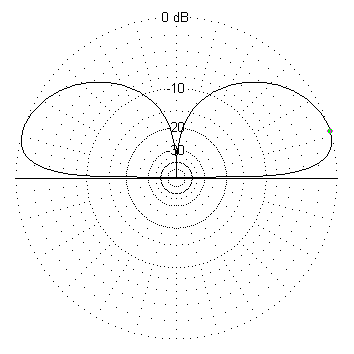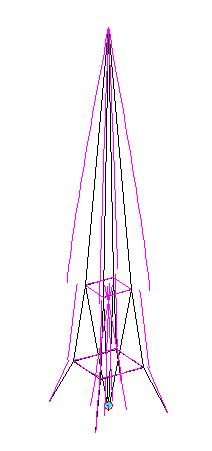
In order to get a rough idea of the performance of such antenna, it has been simulated and the gain, the radiation pattern, the antenna impedance and the current distribution has been calculated. Precise data about the structure are not available and the dimensions have been estimated via observations on site. No antenna performance data is available and therefore the result of the simulation cannot be checked against the reality and may be considerably wrong, but the figures look plausible and are reported and commented below.
The spare antenna of the Sottens transmitter is a vertical self supporting tower 125 m high insulated from ground. The matching network is at the base of the tower, but it's not directly connected to it, but four feed wires connect the tower from the inside at about 40 m above ground. Transmission frequency is 765 kHz, one wavelength is 392 m and a quarter wavelength is 98 m. The antenna is therefore longer than a quarter wavelength.

Ground conductivity has a very big influence on the gain (the higher the conductivity the higher the gain), the elevation angle (the higher the conductivity the lower the angle) and the impedance. Unfortunately no information about ground conductivity is available. A value of 7.5 mS/m has been arbitrary chosen.
The simulation shows a gain of 0.7 dBd (including losses), which is not as good as the 1.5 dBd of the main antenna, but is still fair. The elevation angle is 17° and a half power beam-width of 40°. A very low radiation angle is important for long distance broadcast, but because of its small size, this antenna can only achieve 17° (compared to the 12° of the main antenna). The radiation pattern shows no side lobes at high angles, meaning reduced fading in the reception, which is a very important feature of a broadcast antenna, but still this antenna radiates more energy toward the sky making it less performing against fading as the main antenna.

Because of the elevated feed point, the current distribution on the tower is higher above the connection of the four feed cables at about 40 m above ground than below. The maximum current is 113 A, right above this point; right below the current is only 38 A. The feed impedance at the base matching network is (71 + j91) Ω, meaning that for a power of 600 kW, the feed current is about 92 A and the feed voltage is 10.6 kV. To have a comparison, 600 kW on a 50Ω resistive load require a voltage of 5.5 kV and a current of 110 A.

Connecting the feeder above the tower base is quite curious. The base is insulated from ground anyway, so the reason of this connection is not to save the base isolators. The antenna has been simulated with the feed point at its base to see if there is a difference. For example, the Beromünster spare antenna is fed on its base.
The simulation shows that the gain would be slightly higher (0.8 dBd), the elevation angle would be the same (17°) as well as the half power beam-width (40°). The feed impedance would be now (75 + j28) Ω not very different from the elevated feed. The feed voltage would be around 7.2 kV and the current around 89 A, for the same power. Since the antenna is slightly longer than a quarter wavelength, there is a current maxima of 100 A at about 23 m above ground.
The simulation doesn't show any significant difference between the two feed methods, so either the simulation is wrong, either there is a different reason to justify this choice.